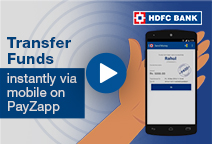You've Been Logged Out
For security reasons, we have logged you out of HDFC Bank NetBanking. We do this when you refresh/move back on the browser on any NetBanking page.
OK- Home
- PAY Cards, Bill Pay
- Money Transfer
- To Other Account
- To Own Account
- UPI (Instant Mobile Money Transfer)
- IMPS (Immediate Payment 24 * 7)
- RTGS (Available 24 * 7)
- NEFT (Available 24 * 7)
- RemitNow Foreign Outward Remittance
- Remittance (International Money Transfers )
- Religious Offering's & Donation
- RemitNow (For Expat)
- Forex Services for students
- Pay your overseas education fees with Flywire
- ESOP Remittances
- Visa CardPay
- Cards
- Bill Payments
- Recharge
- Payment Solutions
- Money Transfer
- SAVE Accounts, Deposits
- INVEST Bonds, Mutual Funds
- BORROW Loans, EMI
- INSURE Cover, Protect
- OFFERS Offers, Discounts
- My Mailbox
- My Profile
- Home
- PAY Cards, Bill Pay
- Money Transfer
- To Other Account
- To Own Account
- UPI (Instant Mobile Money Transfer)
- IMPS (Immediate Payment 24 * 7)
- RTGS (Available 24 * 7)
- NEFT (Available 24 * 7)
- RemitNow Foreign Outward Remittance
- Remittance (International Money Transfers )
- Religious Offering's & Donation
- RemitNow (For Expat)
- Forex Services for students
- Pay your overseas education fees with Flywire
- ESOP Remittances
- Visa CardPay
- Cards
- Bill Payments
- Recharge
- Payment Solutions
- Money Transfer
- SAVE Accounts, Deposits
- INVEST Bonds, Mutual Funds
- BORROW Loans, EMI
- INSURE Cover, Protect
- OFFERS Offers, Discounts
- My Mailbox
- My Profile
- Home
- PAY Cards, Bill Pay

- Money Transfer
- To Other Account
- To Own Account
- UPI (Instant Mobile Money Transfer)
- IMPS (Immediate Payment 24 * 7)
- RTGS (Available 24 * 7)
- NEFT (Available 24 * 7)
- RemitNow Foreign Outward Remittance
- Remittance (International Money Transfers )
- Religious Offering's & Donation
- RemitNow (For Expat)
- Forex Services for students
- Pay your overseas education fees with Flywire
- ESOP Remittances
- Visa CardPay
- SAVE Accounts, Deposits
- INVEST Bonds, Mutual Funds
- BORROW Loans, EMI
- INSURE Cover, Protect
- OFFERS Offers, Discounts
- My Mailbox
- My Profile
- Personal
- Resources
- Learning Centre
- ThisPageDoesNotCntainIconPay
- What is Neft
What is Neft?

25 April, 2024
Synopsis
Funds can be transferred via NEFT either online or offline, with recipient details like bank name and IFSC code required.
NEFT is available 24/7, offering fast, secure and nationwide money transfers.
NEFT charges vary by transaction amount, with no fees for inward or online savings account transfers but nominal fees for outward transactions.
NEFT stands for National Electronic Funds Transfer. It is managed by the Reserve Bank of India (RBI). NEFT is a nationwide electronic payment system that facilitates secure fund transfers between bank accounts across India. NEFT enables individuals, businesses and institutions to send money quickly and securely. To learn more about how NEFT operates, its benefits and associated charges, continue reading
The full form of NEFT is National Electronic Funds Transfer. Owned and managed by the Reserve Bank of India (RBI), NEFT is a pan-India unified electronic payment system that enables fund transfers between bank accounts within the country. This fund transfer platform allows individuals, businesses, and institutions to send money securely from one bank account to another, within minutes. To understand how NEFT works, its advantages and charges, keep reading.
Enjoy instant money transfers at your fingertips. Download PayZapp Money Transfer App and make swift and secure. UPI payments.
How Does NEFT Work?
Let’s explore how NEFT works by breaking down the process into simple steps:
Step 1: Initiating the transfer
Whether you are an individual, firm, or business, you can initiate NEFT transfers in two ways:
Online mode: You can use internet and Mobile Banking services provided by your bank to initiate NEFT transfer. For such transfer, you need to add the beneficiary/recipient’s details, including their name, bank name and branch, IFSC code, and account number. You can authorise fund transfers 30 minutes after adding beneficiary details.
Offline mode: You can visit your bank’s branch to initiate offline NEFT transfers. Simply fill out an NEFT application form, provide the beneficiary’s details and authorise the bank to transfer the specified amount from your account.
Step 2: Message preparation
Your bank generates a message containing transaction details. This message is then sent to the pooling centre, also called the NEFT Service Centre.
Step 3: Forwarding the message to the Clearing Centre
The message is further forwarded to NEFT Clearing Centre, overseen by the RBI. This centre acts as a centralised hub where all the NEFT transactions are organised for processing.
Step 4: Sorting and accounting
At the NEFT Clearing Centre, all the incoming transactions are sorted according to the beneficiary banks. Once sorted, necessary accounting entries are prepared per the originating banks and allocated to beneficiary banks where the recipients holds accounts.
Step 5: Crediting funds to the beneficiary’s account
Lastly, the beneficiary banks receive the inward remittance messages from the NEFT Clearing Centre. They then credit the amount to the recipient’s bank account and a fund transfer confirmation is sent to the relevant stakeholders.
Steps to Transfer Funds Via NEFT
Sending money via NEFT is easy. Just follow these steps.
Log in to your internet/mobile banking account and go to the Fund Transfer/Money Transfer tab.
Choose NEFT as your preferred mode of fund transfer.
Set up beneficiary details per the steps mentioned earlier.
Input the fund transfer amount and reason (optional).
Authenticate the transfer with a One-Time Password sent on your Registered Mobile Number.
The funds will be transferred to the beneficiary within an hour.
What Are The Advantages Of NEFT?
Here’s why NEFT makes for an excellent fund transfer facility.
Faster, secure transactions:
The funds are sent to the recipient’s account quickly. This near-real-time feature ensures that your funds are transferred without unnecessary delays.
Round-the-clock availability:
NEFT services are available 24/7, all year round. You can easily initiate fund transfers at any time, including on bank holidays and weekends.
All-India coverage
The NEFT system covers the entire country, connecting every bank. You do not need to worry about your location. You can just initiate the transfer and the NEFT system will ensure that your money is transferred securely.
Confirmation alerts
The NEFT system sends SMS notifications to both, the sender and the receiver once the fund transfer have been completed safely.
Versatile use:
NEFT is not just for bank transfers. You can use it for various purposes, like paying off credit card bills, insurance premiums, inward remittance, and much more.
NEFT Charges
The applicable NEFT charges are as under:
No charges on inward transactions:
If you are on the receiving end of an NEFT transfer, there are no charges applied when the destination bank receives funds and credits them to your account.No processing charges for outward transactions:
RBI do not levy processing charges when member banks initiate outward transactions.Savings Account holders:
RBI has instructed banks not to charge Savings Account holders for NEFT transactions initiated online to encourage digital payments.Charges for other outward transactions:
Banks may levy charges the following charges for other outward transactions.
Transaction Amount | Maximum Charges |
Up to ₹10,000 | Up to ₹2.50 |
₹10,000 to ₹1 lakh | Up to ₹5.00 |
₹1 lakh to ₹2 lakhs | Up to ₹15 |
Over ₹2 lakhs | Up to ₹25 |
Transfer Funds Instantly With PayZapp
While NEFT enables you to initiate, quick and easy fund transfers, you can also use other modes of payments and transfers. HDFC Bank’s PayZapp is one such mobile application or platform on which you can conduct fund transfers and payments easily. You simply need to download the app, register on it and link your HDFC Bank Account or Credit Card for swift, secure, and seamless payments. With PayZapp, you can earn rewards, discounts, and exclusive deals on online transactions.
Click here to transfer money through PayZapp on your IOS phone
Click here for online money transfer through PayZapp on your Android phone.
*Terms and conditions apply. The information provided in this article is generic in nature and for informational purposes only. It is not a substitute for specific advice in your own circumstances




